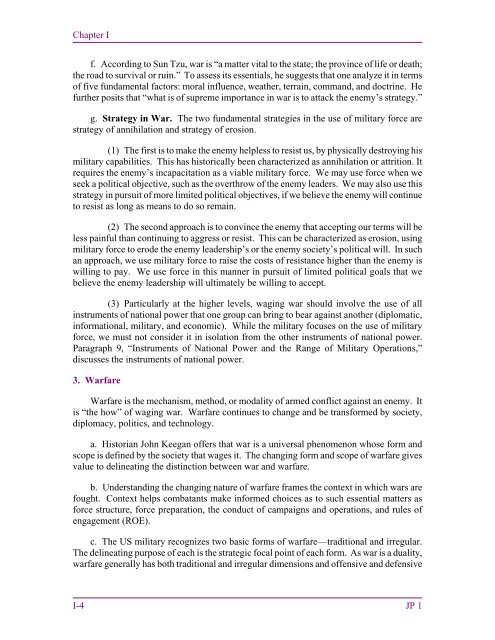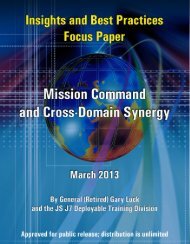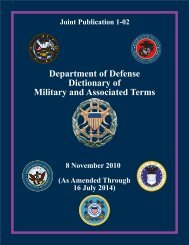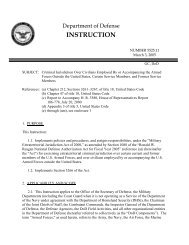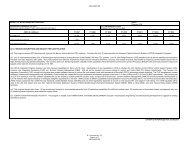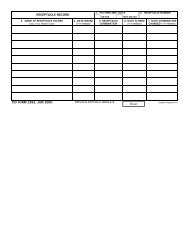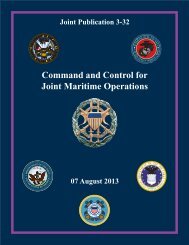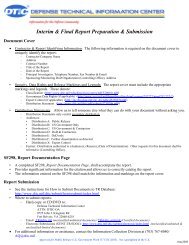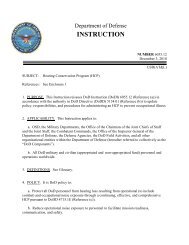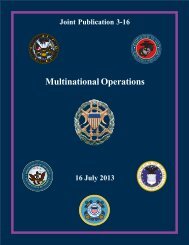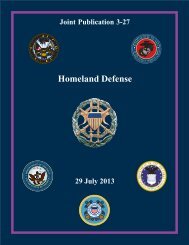JP 1, Doctrine for the Armed Forces of the United States - Defense ...
JP 1, Doctrine for the Armed Forces of the United States - Defense ...
JP 1, Doctrine for the Armed Forces of the United States - Defense ...
You also want an ePaper? Increase the reach of your titles
YUMPU automatically turns print PDFs into web optimized ePapers that Google loves.
Chapter I<br />
f. According to Sun Tzu, war is “a matter vital to <strong>the</strong> state; <strong>the</strong> province <strong>of</strong> life or death;<br />
<strong>the</strong> road to survival or ruin.” To assess its essentials, he suggests that one analyze it in terms<br />
<strong>of</strong> five fundamental factors: moral influence, wea<strong>the</strong>r, terrain, command, and doctrine. He<br />
fur<strong>the</strong>r posits that “what is <strong>of</strong> supreme importance in war is to attack <strong>the</strong> enemy’s strategy.”<br />
g. Strategy in War. The two fundamental strategies in <strong>the</strong> use <strong>of</strong> military <strong>for</strong>ce are<br />
strategy <strong>of</strong> annihilation and strategy <strong>of</strong> erosion.<br />
(1) The first is to make <strong>the</strong> enemy helpless to resist us, by physically destroying his<br />
military capabilities. This has historically been characterized as annihilation or attrition. It<br />
requires <strong>the</strong> enemy’s incapacitation as a viable military <strong>for</strong>ce. We may use <strong>for</strong>ce when we<br />
seek a political objective, such as <strong>the</strong> overthrow <strong>of</strong> <strong>the</strong> enemy leaders. We may also use this<br />
strategy in pursuit <strong>of</strong> more limited political objectives, if we believe <strong>the</strong> enemy will continue<br />
to resist as long as means to do so remain.<br />
(2) The second approach is to convince <strong>the</strong> enemy that accepting our terms will be<br />
less painful than continuing to aggress or resist. This can be characterized as erosion, using<br />
military <strong>for</strong>ce to erode <strong>the</strong> enemy leadership’s or <strong>the</strong> enemy society’s political will. In such<br />
an approach, we use military <strong>for</strong>ce to raise <strong>the</strong> costs <strong>of</strong> resistance higher than <strong>the</strong> enemy is<br />
willing to pay. We use <strong>for</strong>ce in this manner in pursuit <strong>of</strong> limited political goals that we<br />
believe <strong>the</strong> enemy leadership will ultimately be willing to accept.<br />
(3) Particularly at <strong>the</strong> higher levels, waging war should involve <strong>the</strong> use <strong>of</strong> all<br />
instruments <strong>of</strong> national power that one group can bring to bear against ano<strong>the</strong>r (diplomatic,<br />
in<strong>for</strong>mational, military, and economic). While <strong>the</strong> military focuses on <strong>the</strong> use <strong>of</strong> military<br />
<strong>for</strong>ce, we must not consider it in isolation from <strong>the</strong> o<strong>the</strong>r instruments <strong>of</strong> national power.<br />
Paragraph 9, “Instruments <strong>of</strong> National Power and <strong>the</strong> Range <strong>of</strong> Military Operations,”<br />
discusses <strong>the</strong> instruments <strong>of</strong> national power.<br />
3. Warfare<br />
Warfare is <strong>the</strong> mechanism, method, or modality <strong>of</strong> armed conflict against an enemy. It<br />
is “<strong>the</strong> how” <strong>of</strong> waging war. Warfare continues to change and be trans<strong>for</strong>med by society,<br />
diplomacy, politics, and technology.<br />
a. Historian John Keegan <strong>of</strong>fers that war is a universal phenomenon whose <strong>for</strong>m and<br />
scope is defined by <strong>the</strong> society that wages it. The changing <strong>for</strong>m and scope <strong>of</strong> warfare gives<br />
value to delineating <strong>the</strong> distinction between war and warfare.<br />
b. Understanding <strong>the</strong> changing nature <strong>of</strong> warfare frames <strong>the</strong> context in which wars are<br />
fought. Context helps combatants make in<strong>for</strong>med choices as to such essential matters as<br />
<strong>for</strong>ce structure, <strong>for</strong>ce preparation, <strong>the</strong> conduct <strong>of</strong> campaigns and operations, and rules <strong>of</strong><br />
engagement (ROE).<br />
c. The US military recognizes two basic <strong>for</strong>ms <strong>of</strong> warfare—traditional and irregular.<br />
The delineating purpose <strong>of</strong> each is <strong>the</strong> strategic focal point <strong>of</strong> each <strong>for</strong>m. As war is a duality,<br />
warfare generally has both traditional and irregular dimensions and <strong>of</strong>fensive and defensive<br />
I-4 <strong>JP</strong> 1


